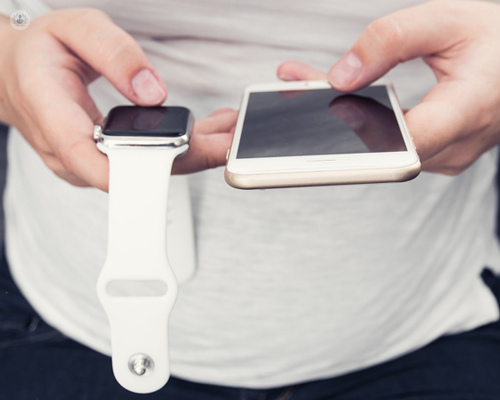Screen for AF with your smartwatch or smartphone
Written in association with:Researchers have recognised the potential of smartphone and smartwatches for pinpointing possibly live-saving information that can assist in diagnosing heart rhythm abnormalities like atrial fibrillation (AF).
Highly-respected cardiologist Professor Dhiraj Gupta, who is also an advisor on AF to the British Heart Foundation (BHF), speaks to Top Doctors all about Preventicus Heartbeats, the app recently presented at the European Society of Cardiology Congress, and other useful apps and tech equipment you can use to potentially detect the condition – as well as exactly what AF is - in this informative article.

Why is screening for atrial fibrillation important?
The causes of a stroke can be AF, and it often goes unnoticed. This leads to symptoms that affect quality of life such as tiredness, sluggish circulation and feeling breathless even without exertion. It’s very important that people know the risks, because people can be at high risk for stroke and heart failure.
Around 1.5 million people in the UK have been diagnosed with the condition, and the number is increasing inexorably.
This rise is due to a combination of actual increased prevalence because of an ageing population and poor lifestyle habits, but also because of better screening due to increased GP awareness and in the medical community.
What has research shown about applications and devices that screen for heart rhythm abnormalities like AF?
Researchers at the European Society of Cardiology Congress last month presented evidence to suggest how smartphone screening could be a way to detect the condition in older people. They conducted a trial of 5.551 adults aged 50 to 90, who were considered at risk of a stroke but had no known AF. They used an app called Preventicus Heartbeats on their smartphones, which effectively measured pulse wave irregularities. These breakthroughs are definitely the way forward.
Northwestern University and Johns Hopkins University researchers have been awarded funding from the US National Heart, Lung and Blood Institute for a study that assesses whether an Apple Watch can be used to reduce patient reliance on blood-thinning medication to prevent strokes.
How do they do it?
Currently, the Apple Watch has apps that can help:
Heart Rate app
Apple Watch wearers can allow notifications from the Heart Rate app on their device. They can set it to receive alerts of an irregular rhythm that might indicate AF.
Workout app
The Apple Watch’s latest operating system, watchOS 9, allows users to access a history of their heart rhythm.
Other technology that can assist in AF diagnosis include:
Fitbit
Fitbit activity trackers have an ‘Irregular Rhythm Notification’ that have been validated in clinical trials. They claim that heart rhythm data is recorded while you slept, and is analysed for signs of AF.
KardiaMobile device
This is a NICE (National Institute for Health and Care Excellence)-approved device that detects arrhythmia from a finger pad and sends ECG results to an accompanying app within 30 seconds to see if your heart rhythm is abnormal.
The Apple Watch and the KardiaMobile device, in particular, are excellent. Scientific studies have validated their auto-diagnosis algorithms. Given that standard methods of AF diagnosis aren’t very useful, these wearable devices can monitor heart rhythm constantly and it makes them very useful. This is the way to go for more people to use these devices to warn them of their heart condition.
What is AF?
AF is a heart rhythm abnormality that occurs when electrical impulses that trigger muscle contractions of the heart, which misfire in a disorganised way.
When the normal pumping action of the atria, the two upper chambers of the heart, is disrupted, AF occurs. This results in an erratic and sometimes, an alarmingly rapid heart rate of 300 beats per minute, or more.
AF means that the ventricles, the heart’s lower pumping chambers responsible for blood circulation throughout the body, are thrown out of sync. This may mean physiological needs aren’t met.
What are the symptoms of AF?
There are no symptoms in about one third of patients. This means that it often goes undiagnosed.
Some people have mild symptoms such as:
- fatigue;
- light-headedness;
- slight breathlessness on exertion.
Learning how to check your pulse is invaluable. If it seems irregular and doesn’t follow a steady pattern, you should speak to your GP.
The standard test to diagnose AF is an electrocardiogram (ECG), although it isn’t foolproof. Patients might experience intermittent abnormal rhythms in the early stages of AF, but at other times their heart beats normally. This is known as paroxysmal AF, which doesn’t always show up, even on ECGs.
It may be recommended in these cases, that patients use a cardiac event recorder. This is a small device that records your heart rate and rhythm when symptoms occur.

What age groups are most at risk of AF?
Getting older is an unavoidable risk factor, while developing AF before the age of 60 to 65 can mean that genetics are involved.
However, our lifestyles also contribute to AF risk. If you are overweight or obese, then substantial weight reduction of more than 10 per cent of your body weight has been shown to decrease the burden of AF symptoms. Regular exercise can be helpful if it contributes to weight loss, and avoiding stress provides extra protection.
How can people manage the risk of developing AF?
Lifestyle factors such as alcohol and caffeine intake are worth considering when it comes to managing the risk of developing AF.
In a nine-year study of caffeine and its link to AF, featured in the Journal of the American Heart Association, it was found that men drinking one to three cups of coffee a day were shown to be at lower risk for AF.
However, alcohol can raise the risk of AF and it irritates the cells in the heart that can trigger an AF attack. It was published in the European Heart Journal last year than just one drink a day could raise the risk of AF. If people consumed two small drinks a day, the risk rose to 28 per cent and for more than four drinks, it was 47 per cent.
What can happen if it’s left untreated?
The risk of a blood clot developing, which can lead to a stroke, can be increased, even if you have no symptoms. The disorganised electrical activity that characterises AF means that the heart doesn’t pump as efficiently as it should, which increases the risk of heart failure.
Cardiologists at Vanderbilt University Medical Centre presented that if AF is left untreated, it can heighten the risk of stroke by fourfold in men and almost sixfold in women. The paper, published in the New England Journal of Medicine, also suggested that untreated AF will raise the risk of heart failure by three times and 11 times respectively.
How is atrial fibrillation treated?
AF is a very treatable condition if it’s diagnosed early. Drugs such as sotatol, amiodarone and flecainide are usually prescribed to steady heart rate, but if someone is suspected to have had AF for a longer amount of time, they may be given beta blockers.
Some patients may be required to be fit with a pacemaker. Other options to restore regular heart rhythm surgically include:
- Catheter ablation;
- Cardioversion, which is a 30-minute procedure in which electrodes connected to a defibrillator provides controlled electric shocks to the chest wall.
The earlier you receive treatment, success rates are higher.
If you’re concerned about AF, or other heart rhythm abnormalities, arrange a consultation with Professor Gupta via his Top Doctors profile.


